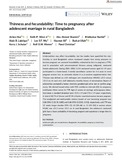| dc.contributor.author | Hur, Jinhee | |
| dc.contributor.author | West, Keith P. | |
| dc.contributor.author | Shamim, Abu Ahmed | |
| dc.contributor.author | Rashid, Mahbubur | |
| dc.contributor.author | Labrique, Alain B. | |
| dc.contributor.author | Wu, Lee S.F. | |
| dc.contributor.author | Ali, Hasmot | |
| dc.contributor.author | Ullah, Barkat | |
| dc.contributor.author | Schulze, Kerry J. | |
| dc.contributor.author | Klemm, Rolf D.W. | |
| dc.contributor.author | Christian, Parul | |
| dc.date.accessioned | 2022-05-10T04:15:07Z | |
| dc.date.available | 2022-05-10T04:15:07Z | |
| dc.date.copyright | 2020 | |
| dc.date.issued | 2020-03-24 | |
| dc.identifier.citation | Hur, J., West, K. P., Jr., Shamim, A. A., Rashid, M., Labrique, A. B., Wu, L. S. F., . . . Christian, P. (2020). Thinness and fecundability: Time to pregnancy after adolescent marriage in rural Bangladesh. Maternal and Child Nutrition, 16(3) doi:10.1111/mcn.12985 | en_US |
| dc.identifier.uri | http://hdl.handle.net/10361/16582 | |
| dc.description | This article was published in Maternal Child Nutrition by Wiley [ © 2020 The Authors. Maternal & Child Nutrition published by John Wiley & Sons Ltd] and the definite version is available at: https://doi.org/10.1111/mcn.12985 The Journal's website is at: https://onlinelibrary.wiley.com/doi/full/10.1111/mcn.12985 | en_US |
| dc.description.abstract | Undernutrition may affect fecundability, but few studies have quantified this relationship. In rural Bangladesh, where newlywed couples face strong pressures to
become pregnant, we assessed fecundability, estimated by time to pregnancy (TTP),
and its association with preconceptional thinness among nulligravid, newlywed
female adolescents. During 2001–2002, 5,516 newlywed women aged 12–19 years
participated in a home-based, 5-weekly surveillance system for 5–6 years to enrol
pregnant women into an antenatal vitamin A or β-carotene supplementation trial.
Thinness was defined as a left mid-upper arm circumference (MUAC) ≤21.5 versus
>21.5 cm. At each visit, staff obtained a monthly history of menstruation. Report of
amenorrhea prompted a human chorionic gonadotropin urine test to confirm pregnancy. We derived hazard ratios (with 95% confidence intervals [CI]) for pregnancy
and Kaplan–Meier curves for TTP. Ages of women at marriage and pregnancy detection (mean ± standard deviation) were 15.3 ± 1.9 and 17.0 ± 1.9 years, respectively.
A total of 82.7% of thinner and 87.3% of better nourished women became pregnant.
The unadjusted and multivariable relative hazard of ever becoming pregnant was
0.84 (95% CI [0.78, 0.89]) and 0.86 (95% CI [0.81, 0.92]), respectively, and TTP was
12 weeks longer (median [95% CI]: 63 [58–68] vs. 51 [49–54]) in women whose
MUAC was ≤21.5 versus >21.5 cm. In rural Bangladesh, thin adolescent newlywed
girls have a lower probability of becoming pregnant and experience a longer time to
pregnancy. | en_US |
| dc.language.iso | en_US | en_US |
| dc.publisher | Wiley | en_US |
| dc.relation.uri | https://onlinelibrary.wiley.com/doi/full/10.1111/mcn.12985 | |
| dc.subject | Adolescent girls | en_US |
| dc.subject | Arm circumference | en_US |
| dc.subject | Bangladesh | en_US |
| dc.subject | Fecundability | en_US |
| dc.subject | Pregnancy | en_US |
| dc.subject | South Asia | en_US |
| dc.subject | Undernutrition | en_US |
| dc.title | Thinness and fecundability: Time to pregnancy after adolescent marriage in rural Bangladesh | en_US |
| dc.type | Journal Article | en_US |
| dc.description.version | Published | |
| dc.contributor.department | Brac James P. Grant School of Public Health | |
| dc.identifier.doi | https://doi.org/10.1111/mcn.12985 | |
| dc.relation.journal | Maternal & Child Nutrition | |

